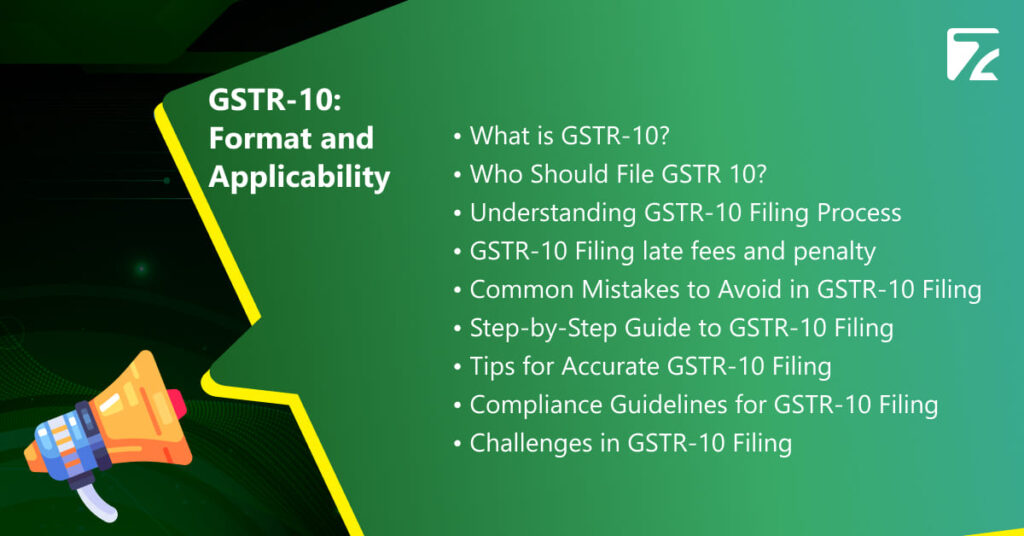GSTR 10 Filing Guide: Simplify Your Final Return
- Latest Update Regarding GSTR 10 Form : 03rd April 2023
- What is GSTR 10?
- GSTR-10 applicability: Who Needs to File GSTR 10?
- GSTR-10 due date: When to File GSTR 10?
- Steps to File GSTR 10
- Important Details to Include in GSTR 10
- Penalties for Non-Filing of GSTR-10
- Difference Between GSTR 9 (Annual Return) & GSTR 10 (Final Return)
- Conclusion
Filing your GSTR 10, also known as the Final Return, is a crucial step in the overall GST return filing Process for businesses winding up their operations.This comprehensive guide will walk you through everything you need to know to simplify your GSTR 10 filing. Whether you’re a seasoned business owner or a new entrepreneur, this guide is designed to make your final return process as smooth as possible.
Latest Update Regarding GSTR 10 Form : 03rd April 2023
- In the period April 1 to June 30, 2023, the late fee for filing GSTR-10 is restricted to Rs. 1,000.
- “CBIC shared the latest update about upcoming functionalities for the taxpayers on the GST official portal in July 2021 month.”
- “Seeks to grant waiver / reduction in late fee for not furnishing FORM GSTR-10, subject to the condition that the returns are filled between 22.09.2020 to 31.12.2020.”
- “Relief in late fees to Taxpayers filing Form GSTR-4 or 10 and change in navigation of Comparison of liability declared and ITC claimed report”.
What is GSTR 10?

E-invoicing, or electronic invoicing, is a big step from the old ways. It’s part of India’s effort to make tax dealings easier and more accurate under GST. This change makes things simpler for both businesses and the tax authorities. Now, let’s see what it’s all about and why it matters so much.
GSTR-10 applicability: Who Needs to File GSTR 10?
Any taxpayer whose GST registration has been cancelled or surrendered must file GSTR 10. It is important to understand how supply of goods and services is treated under GST to ensure accurate filing. This includes:
- Businesses voluntarily cancelling their GST registration
- Taxpayers whose GST registration has been cancelled by the GST authorities
GSTR-10 due date: When to File GSTR 10?
The GSTR 10 form must be filed within three months from the date of cancellation or the date of cancellation order, whichever is later. Understanding the place of supply rules can help ensure the correct filing period is considered. Failing to file this return can result in a notice from the tax authorities and penalties.
For instance, if the date of GST registration cancellation is 1st January 2025 and the taxpayer has received the cancellation order on 5th January 2025. Then, the concerned business must file GSTR-10 by 5th April 2025
Steps to File GSTR 10
The steps to file GSTR-10 are similar in structure to other GST filings such as GSTR-1. Here’s a step-by-step guide to help you through the process:
- Log In to the GST Portal: Visit the GST portal and log in with your credentials.
- Navigate to Final Return: Go to ‘Services’ > ‘Returns’ > ‘Final Return’.
- Fill in the Details: Enter the necessary details such as Application Reference Number (ARN) of the cancellation order, date of cancellation, and the relevant tax period.
- Enter Stock Details: Provide details of inputs held in stock, semi-finished or finished goods, and capital goods or plant and machinery.
- Sign and Submit: After verifying the details, sign the return using DSC or EVC and submit.
Visit Manual (gst.gov.in) for detailed step by step process
Important Details to Include in GSTR 10
- GSTIN: Your GST Identification Number
- Legal Name of the Business: As per your GST registration
- Address: Registered address of the business
- Date of Cancellation: The date from which the cancellation is effective
- Stock Details: Inputs, semi-finished goods, finished goods, and capital goods held on the last day before the cancellation date
Below are the sections under which information needs to be furnished
- Effective Date of Surrender/Cancellation: Here you need to mention the date of cancellation of GST registration as contained in the order.
- Reference number of Cancellation order: Unique ID will be provided by the authorities at the time of passing cancellation order.
- Date of Cancellation Order: This will be the date on which the GST registration cancellation order is passed by the authorities.
- Particulars of Closing Stock: The taxpayer needs to furnish details of closing stock held at the time business ceases. Any amount of input tax credit lying in such stock needs to be paid along with this return.
- Inputs in stock (invoice present)
- Inputs in the stock of semi-finished or finished goods (invoice present)
- Capital goods or machinery in stock
- Inputs in stock or in stock of semi-finished or finished goods (invoice not present)
- Tax payable amount and tax paid: Give ITC reversal or tax payable as well as paid, and transfer from electronic cash and credit ledgers as per the heads- CGST, SGST, IGST and Cess details.
- Interest, late fee payable and paid: Give head-wise break up of the interest and late fee payable and paid.
- Verification: Verify and confirm the correctness of the particulars of the GSTR-10.
Once all the particulars are furnished correctly, the taxpayer is required to sign digitally either through a digital signature certificate (DSC) or Aadhaar based signature verification to authenticate the return.
Penalties for Non-Filing of GSTR-10
Failing to file GSTR 10 can attract heavy penalties, including a late fee of Rs. 100 per day per Act (CGST & SGST) and a maximum penalty of Rs. 10,000.
Difference Between GSTR 9 (Annual Return) & GSTR 10 (Final Return)
Annual return is to be furnished by every registered taxpayer in a normal condition under the GST regime. Annual return or
GSTR-9 is filed once in a year by taxpayers.
While Final return form or GSTR-10 is to be furnished by only the taxpayers whose registration has been surrendered or cancelled.
Common Mistakes to Avoid When Filing GSTR-10
- Incorrect Stock Details: Ensure that all stock details are accurate and up-to-date.
- Missed Deadlines: File within the stipulated time to avoid penalties.
- Incorrect Cancellation Date: Double-check the effective date of cancellation before filing.
Conclusion
Filing your GSTR 10 accurately and on time is essential to ensure a smooth closure of your GST registration. By following this guide, you can simplify the process and avoid common pitfalls. Remember, staying compliant with GST regulations is crucial for the seamless winding up of your business.
Non-filing of GSTR 10 can lead to penalties and legal notices from the tax authorities.
No, once GSTR 10 is filed, it cannot be revised. Ensure all details are correct before submission.
The late fee is Rs. 100 per day under CGST and Rs. 100 per day under SGST, subject to a maximum of Rs. 10,000.
Yes, GSTN has provided an offline tool for filing GSTR-10.
No, a GSTR 10 certificate is not mandatory if an individual has already registered as a taxpayer under GST.
